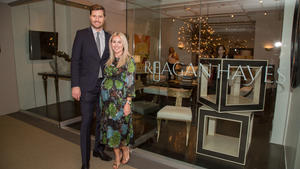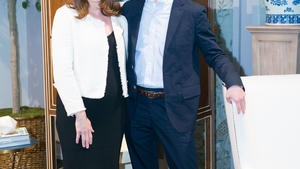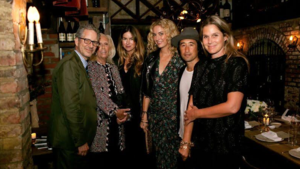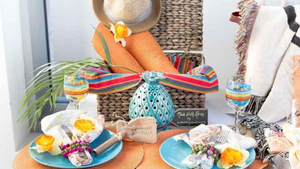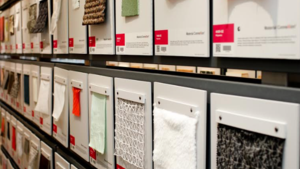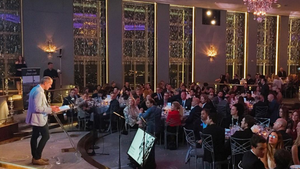American decorator and distinguished socialite Elsie de Wolfe hosted lavish parties in Paris during the interwar years. Her high-society gatherings and fabled house, the Villa Trianon in Versailles, were once the stuff of haut monde preference and, later, legend. Last week, cultural historian and author of Elsie de Wolfe's Paris: Frivolity Before the Storm Charlie Scheips recounted de Wolfe’s illustrious lifestyle at New York School of Interior Design (NYSID), showcasing rare or never-before-published images of the designer herself, as well as the bon vivant lifestyle she proffered.
Margaret Russell and Charlie Scheips. Photograph courtesy of John Minier.
To begin the lecture, Scheips briefly touched on de Wolfe’s life, which spanned the 92 years between the Civil War era to the post-World War II years. During her career as an interior designer, de Wolfe decorated the Colony Club with French Interior Designer Stephane Boudin, which catapulted her career into working with high-society clientele like Anne Vanderbilt, Anne Morgan, the Duke and Duchess of Windsor, and Elizabeth Milbank Anderson.
De Wolfe spent much of her time in Europe working with clients and rubbing elbows with turn-of-the-century aristocrats. In 1903, she stumbled upon a house in ruin bordering the royal gardens of Versailles. Over the next three decades, she transformed the abandoned residence into what would become the location for her infamous parties—Villa Trianon.
“It is like a window into another world,” said Scheips. “It wasn’t just about one night, it was about an end of an era and that era ended pretty much in the beginning of 1938. Paris went completely mad for parties.”
Coco Chanel and Serge Lifar and friends arriving at Villa Trianon. Photograph courtesy of Roger Schall.
By the late 1930s de Wolfe, also known as Lady Mendl, held two noteworthy parties—her Circus Balls—marking the end of the social scene before the Second World War.
“[Villa Trianon] is the petri dish for the rest of her life and it all goes through lots and lots of changes,” said Scheips. “For the height of the social season she worked with Vogue Social Columnist John McMullen and Jansen’s Stephane Boudin on the ballroom for her summer Circus Balls.”
Music pavilion at Villa Trianon. Photograph courtesy of Charlotte Moss
The first incarnation of the ballroom in 1938 merged the loggia and the terrace to set the stage for de Wolfe’s grandest fetes. The ballroom included a spring dance floor imported from England, sliding Japanese screens, and surrealist trees for columns. Everything, naturally, was hung with a striped canvas.
"It's a period of unbridled glamour and luxury,” Scheips said. “Nobody worked. Women had the time to get up, have their hair done and have lunch at the Ritz. Men didn’t work; they had appointments. After the war, that world vanished and it never came back in the same way.”
When World War II commenced, de Wolfe fled Europe to New York where she decorated the St. Regis Hotel in exchange to live there. Industrialist Paul Louis Weiller owned the Versailles property after de Wolfe’s death. In 1999, the present owner bought Villa Trianon, but it was quickly abandoned after a terrible storm hit Versailles one week later.
After reaching out to the current owners, Scheips paid a visit to Villa Trianon, which had not been six decades save for decay and neglect..
“I thought it was very much like when Elsie was in 1903 when she first was peering through the gates,” Scheips said. “The owners were about 15 minutes late and I had goosebumps. I almost couldn’t see past the fence because the growth of all the vegetation was so thick.”
The author then shared before and after photos of the Villa and how so little had changed—the striped canvases were still hanging in the ballroom and the loggia architecture was still intact.
Scheips concluded his lecture with a special announcement: Inspired by Scheips and Elsie de Wolfe's Paris, the current owner are going to restore the property to its former glory.
















